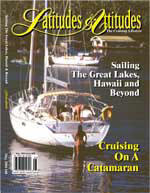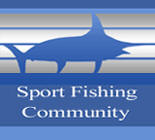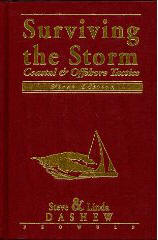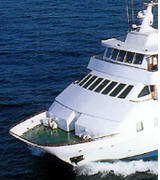|
A para-anchor can save the day”
By Zack Smith
appearing in the 2001 issue of Latitudes and Attitudes.
It’s amazing how quickly a calm, clear day can turn. Many sailors
have experienced it. They’re sailing along, enjoying the
day, then boom. Clouds roll in, the seas begin to pitch
and gale winds start up. It’s as if the elements are
trying to whip your vessel into submission. I spent six
hours like that during a recent outing with a partner. I
dodged breaking waves and surfed downwind on the backs
of 15 ft. swells until I was exhausted. Every decision,
every storm tactic I used, became crucial. I couldn’t
afford to make mistakes. And there’s no way I could
listen to the macho side of my sailing ego that
whispered, “real men sail all day and night in high
winds and waves like this. They don’t get tired!”
But I was tired. Very tired. And this was real life. My
legs were almost paralyzed from sitting on the cockpit’s
hard, cushionless seat. And I couldn’t ignore the sharp
pain that started at my wrist and crawled up my arm. My
neck was locked into a single, static position. I
couldn’t turn my head without pain. I guess that’s what
I get for holding onto the wheel so tightly and for so
long! But I didn’t have much choice. The seas were
building.
I watched the sky grow darker and darker. I looked to my
sailing partner for some assistance. Maybe he could take
the wheel for a while and give me a break. But that
would be a mistake. His face was chalk white as he sat
slouched over in his seat. No doubt about it. This
towering hulk of a man, my long-time sailing buddy, was
seasick! It was clear that he couldn’t be much help to
me. If we were going to get our Catalina 35 safely back
to port, I’d have to be the one to do it. But how, when
I was so exhausted? Continuing without rest might end
badly. “You can make it,” my ego whispered. “You’ve
sailed in nastier conditions than this before.”
Maybe so, but that’s no reason to ignore my exhaustion.
I had been fighting the waves and wind for hours. I
didn’t want to make the mistake that new and seasoned
sailors alike sometimes do when pushing it too long. I
decided not to follow my ego into danger. I looked at my
parachute anchor lashed down on the bow deck. It was
rigged and ready for deployment. It was the only way I
could get any rest. The anchor would keep the boat
bow-to the seas, which is much better than laying ahull,
especially in severe weather like my partner and I were
experiencing.
The decision was made. Off the windward bow I deployed a
boat fender connected to a 50-foot floating line. I
followed that up with a nine-foot para-anchor and a
hundred feet of anchor rode. Our boat settled down
immediately. After securing the boat and checking our
position, I could finally rest. What a relief!
The Moral? Listen to your body. Exhaustion and
seasickness are good reasons to use a parachute sea
anchor. It’s a good idea to practice using your safety
gear before heading out of port. Parachute anchors, in
general, can pack down easily into small containers.
They’re also easy to deploy, even if you’ve had little
experience with them. When properly used, they can save
your life in heavy sea conditions. And, at the very
least, they offer you greater peace of mind and a little
sleep when you need it.
|
|

 “You’re tired. The seas are high.
“You’re tired. The seas are high.













